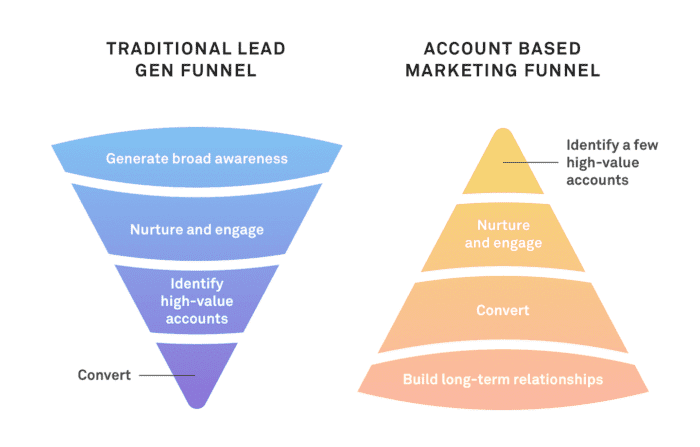Account Based Marketing and the Inverted Funnel

What is Account Based Marketing (ABM)?
When it comes to explaining Account Based Marketing, the graphic below is often cited with the inverted funnel structure as a complete explanation, but while that looks great on a slide, it doesn’t do much to cover the unique advantages and challenges associated, in my opinion. So I’ll attempt to lay both out in this article. At its most basic level, ABM is a targeted B2B strategy that more closely mirrors the traditional sales process than the standard digital marketing process of casting a wide net with progressively fewer prospects making it down to each level of the funnel. Rather than broad characteristics of your target audience, you select a few high-value targets and attempt to target and tailor your message to them directly. The advantage of this is increased messaging control and personalization while the challenges mainly stem from the fact that most digital marketing platforms are built to best support the traditional funnel model.

Why Should I be Interested?:
ABM gives you the opportunity to target a limited group of high-value targets with a high volume of custom marketing content vs casting a wide net across an industry or search terms. It also pairs up sales and marketing goals more closely so that they can provide support to each other’s efforts more directly.
How To Set Up Your Business to Leverage ABM:
As mentioned before, you’ll need to involve the sales team in both the selection process and tracking/qualification. ABM marketing is much more targeted and high-touch than traditional B2B marketing so this planning step is critical to the overall success of the campaign.
Important Considerations:
- Identify top priority target companies as well as job functions within those companies that will have an impact on selection of your product
- Obtain any lists or targeting information available on those companies from your own data or outside vendors
- Set up a system to track priority leads within your CRM and to share that data in real-time with marketing (usually an integration for lead lifecycle stage based conversion actions and value rules to assign higher value to leads that make it deeper into the process)
- Set up the creative resources necessary to individualize creative for the target companies across platforms including digital marketing and email as well as traditional outreach
- Utilize any selling points that sales has found are top arguments with potential prospects
- Find platforms/targeting combinations that allow you to reach your target company and job titles without shrinking the audience to the point that it won’t run (This is where intimate knowledge of the targeting capabilities of platforms and experimentation over time are invaluable)
Making ABM Work With Existing Digital Marketing Platforms:
On that last point above, this is where some of the art comes in. I mentioned that most digital marketing platforms are set up for the traditional broad, top-down funnel approach to B2B marketing, so how do you bend them to work with ABM principles?
There are a few potential approaches depending on the platforms you are using. In any case, if you can get a list of high-value targets at the companies you’re targeting, the best targeting is going to be based on that list of contacts. Often, professional conferences and events will sell these lists, or you could always use something like mobile ad ID capture at the event to generate the targets yourself. Going more broad, with something like LinkedIn Ads, you can directly target the companies you are going after and add filters for the correct department or job title (ex. “Purchasing Dept.” or anyone with a “manager” level title. Facebook/Instagram and google display/video ads can be effectively leveraged on the retargeting side for their low CPM and ability to follow potential prospects once they are in the funnel, driving final conversion on products which may have a long decision cycle for an organization. Email marketing is another major enabler here and you’ll want to make sure you have a targeted and effective sequence to follow up with any potential prospects as well.
Measuring Success:
When It comes to measuring success from an ABM campaign, your intermediate metrics will look much like those of a traditional sales funnel. You’ll want to track potential prospects from first click, through submitting their first information, all the way to final sale. The difference is that your ultimate metric of success will look more like crossing names off of a list of high-value targets. This requires closer coordination with the sales team and/or integration with the business’ CRM system on a level not usually required in the B2B space, but the result is a much clearer and more targeted sales picture.
Would My Business Benefit from an ABM Strategy?
This will depend on a number of factors including your ability to integrate the necessary tracking throughout the sales funnel, correctly identify targets, and leverage the often imperfect targeting options available to you to saturate those targets to the fullest extent possible. It requires close alignment and coordination between sales and marketing as well as a capable digital team to follow through on implementation from lead to final sale. If you are interested, feel free to reach out to us and we can evaluate if ABM digital marketing could be an effective tool for you!











